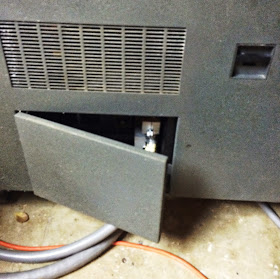The bulbs in the display panel have extremely brittle wires coming out of the glass envelope - just a slight jar is enough to snap them off. I am trying to replace only the bulbs that are not working, but my first trial at this on the SBR line of lamps ended up with a change of almost half, up from the two that were originally burned out.
 |
| Bulbs inside display panel, wires fracture at bulb glass with slightest touch |
 |
| Trying to swing one board out and replace isn't working - on to plan B |
Armed with my ohmmeter, I repeatedly checked the bulbs across a board as I replaced bad ones, until I had a board that had all bulbs working. It was time to slide it into the plastic grid, which sometimes resulted in another old bulb failing.
By the time I got to the third register board (SBR), I no sooner replaced one bulb than another old one failed - eventually 13 of the 16 went bad. This is just too fragile and impossible to get all six boards back into the plastic grid without jostling even one bulb. The only solution is to pick up 156 new bulbs and replace them all. The new bulbs are not susceptible to breakage from insignificant touches, while the metal wires in the old lamps has suffered some degradation that turned them from ductile to brittle.
Looking for a good source for T2 base wire lead incandescent bulbs, flat face with a 4.5V nominal voltage and a draw of 140ma at that level. Once I find the source I will pick up a couple hundred bulbs.
TYPEWRITER RESTORATION CONTINUES
I tested the rewiring of the typewriter local modification where I added a connector in the wiring to allow the front panel to be fully detached from the typewriter mechanism. Next, I did some more encouragement of the various moving parts in the typewriter to free up the congealed lubricants and let my replacement oil work its way in. Not where I need to be yet, but it does take patience to free up one of these mechanisms.
MEMORY ERROR DIAGNOSIS WORK
I did some load and display work on memory to clarify what is not working up to snuff. I found that the upper 8K of memory consistently stored bits 1 and 5 even when the intended value of those bits was zero. Reading this back will cause a parity error if one of those bits is intended to be on and one intended to be off. This is because the parity is calculated on the intended value to store, with each half of the word setting the parity bit if there are an even number of 1 bits. If we flip both bits 1 and 5 from a zero to a one, we don't change the evenness. If both bits are already on, we don't change the evenness. It is only if we flip one and leave the other alone that we perturb the evenness.
The reason those bits would be on is failure of the inhibit sense lines - in a core memory, all bits in the word are driven with the current sufficient to flip the bit on, but any bit that should have zero value will have an 'inhibit sense' current of the opposite polarity which blocks the magnetization. If the inhibit sense line does not drive a current to the bit, it will be set to 1. Both bits 1 and 5 are driven by exactly the same SLT card, a type 3574 in location C4 of the compartment. That is also the exact location where there is a red jumper hooked to one pin on the backplane side but the other end of the jumper is dangling loose. I consider that suspicious but not definitive.
My other problem, the failure to read any words whose address has a certain bit pattern xxxxxxxxx100xxxx, is traceable to a single SLT card except for one anomaly. This error occurs in all 16K of memory, which is spread across two compartments and thus shares no common cards. I am not convinced it is a bad driver/gate card since it spans both of the memory boards. I will have to look for other possible causes that may be more subtle but which would cause a common failure mode on two independent storage boards, 0-8K and 8-16K.
PLANNING LUBRICATION AND ADJUSTMENTS
Like yesterday, there wasn't a lot of free time today, but I did get the items above handled in the early evening. I took in the maintenance manuals and did some reading in preparation for future cleaning and lubrication of key items - disk drive, card reader, and printer.
 |
| Gratuitous picture of 1442 signal and power cables connected to 1131 processor |
No comments:
Post a Comment